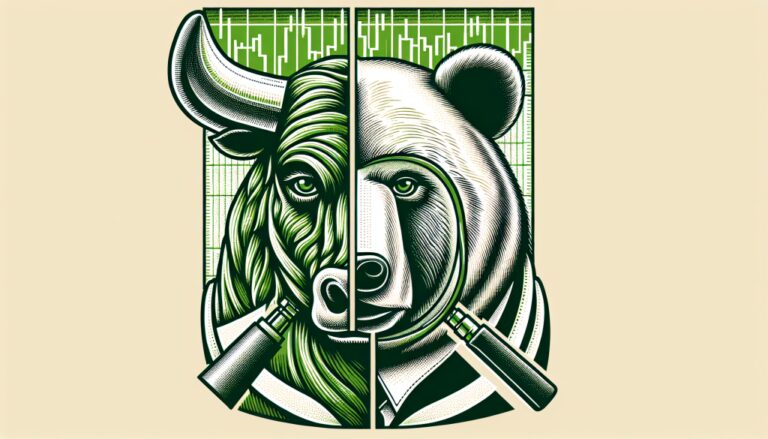The stock market is a fascinating and constantly evolving entity. It is a dynamic landscape influenced by a myriad of factors. One of the most prominent indicators of the health and trajectory of the stock market is the S&P 500, an index that measures the stock price performance of the 500 largest companies listed on U.S. stock exchanges. So far this year, the S&P 500 is up an impressive 19.5%, which typically indicates a strong and thriving market. But beneath this seemingly positive surface, underlying currents suggest a more subtle and potentially worrying situation.
Amazing rise in bond prices
One of the most worrying trends is the recent rise in bond prices. Bonds are essentially loans made by investors to entities such as governments or businesses, and are generally considered a safe haven during times of economic uncertainty. When bond prices rise, it often indicates that investors are moving money from riskier assets such as stocks to safer assets such as bonds. This is known as a “risk-off” trade and typically indicates increased recession risk.
Gold price hits all-time high
In addition to rising bond prices, gold, another traditional safe-haven asset, is also selling at all-time highs. This is another sign that investors are increasingly risk-averse and looking to protect their wealth in the face of a potential economic downturn.
S&P500 continues to rise
Meanwhile, the S&P 500 index continues to rise despite these warning signs, selling at all-time highs. This suggests that the stock market is largely ignoring these recessionary signals and operating on the assumption that there is nothing to worry about. This is the only way to justify the stock's current valuation, which is expensive by any measure.
overvalued stocks
To put this into perspective, the S&P 500 currently trades at a price-to-earnings ratio of 21 times. This means that investors are willing to pay $21 for every $1 of revenue the company generates. This is a high number by historical standards and suggests the stock is overvalued.
Historically, when a stock starts with such a high valuation point, its subsequent five-year return has been relatively low, with an average annual return of just 3%. This suggests that current high valuations are not sustainable and a correction may be on the horizon.
September is always a recession, but it will also affect future elections.
Adding to the potential volatility is September, before the election, which is historically the worst month of the year for the stock market. For the past three years, the stock market has fallen significantly in September, with losses of 5%, 9%, and 5%, respectively.
Additionally, we are approaching a presidential election. Increased uncertainty and volatility stock market.
Stock market dichotomy
In summary, the stock market currently faces a dichotomy. On the other hand, stock valuations are historically high, suggesting optimism and confidence in the market. Meanwhile, rising bond and gold prices suggest investors are becoming increasingly cautious and bracing for a potential economic downturn.
This dichotomy is further exacerbated by the fact that September is a historically volatile month for the stock market and the presidential election is looming. These factors suggest that the stock market may be entering a period of turmoil.
The need for vigilance and preparedness
In conclusion, while the S&P 500's impressive rise this year may suggest a thriving market, the underlying trends suggest a more complex and potentially concerning picture. Investors should therefore approach the market with caution and prepare for potential volatility in the coming months.
For those looking for accurate, up-to-date, data-backed stock market information, it's important to stay informed and stay on top of the latest trends and developments. By doing so, investors can make informed decisions and navigate the complexities of the stock market with confidence and clarity.
FAQ
Q. What is S&P500?
The S&P 500 is an index that measures the stock price performance of the 500 largest companies listed on U.S. stock exchanges.
Q. What does the rise in bond prices indicate?
Rising bond prices often indicate that investors are moving money from riskier assets such as stocks to safer assets such as bonds. This is known as a “risk-off” trade and typically indicates increased recession risk.
Q. Why is the gold price at an all-time high?
Gold prices are at all-time highs as investors become increasingly risk-averse and seek to protect their wealth in the face of a potential economic downturn.
Q. What does the continued rise in the S&P 500 indicate?
The continued rise in the S&P 500 index suggests that the stock market is largely ignoring recession signals and operating on the assumption that there is nothing to worry about.
Q. What does it mean when a stock is overvalued?
When a stock is overvaluedinvestors are willing to pay a high price for every dollar of profit a company generates.. This is a high number by historical standards and suggests the stock is overvalued.
Q. What is the September effect?
The September effect refers to the historical tendency for September to be the worst month of the year for the stock market. For the past three years, the stock market has fallen significantly in September. It's great that October is almost over, but the markets are all down right after the election as well.
Q. How does the presidential election affect the stock market?
Presidential elections often result in increased uncertainty and volatility in the stock market.
Q. What is the dichotomy in the stock market?
of Stock market dichotomy refers to the current situation. Stock valuations are historically high, suggesting optimism and confidence, while rising bond and gold prices mean investors are becoming increasingly cautious and bracing for a potential economic downturn. It suggests that.
Q. How should investors approach the market given current trends?
Investors should approach the market cautiously and prepare for potential volatility in the coming months. It's important to stay informed and aware of the latest trends and developments.


